You can do email marketing only if you have an active user base. Even if you already have an email list, you still need to acquire customers to maintain your email list as, over time, you will churn inactive and disengaged users.
So, how do you acquire new customers to build and maintain your email list? What are the effective strategies for email acquisition? We will discuss 11 effective tactics you can use to get more leads to build your email list.
Table of contents
- What is email acquisition?
- Why does email acquisition matter?
- 11 email acquisition strategies you can use
- Way forward
What is email acquisition?
Email acquisition is getting new customers to grow and build a quality email list using inbound and outbound marketing strategies. It begins with identifying your target audience, reaching out to them, educating them through valuable and relevant content, and encouraging them to sign up for your email list.
But, before you begin developing your acquisition strategy, ask yourself this question - Who do you want to be a part of your email list? Because you don't want to get a huge number of subscribers, spend money and effort to nurture them, only to get unsubscribed after a few days. You need to identify potential customers. Thus, who is on your email list matters more than how many subscribers you have.

Why does email acquisition matter?
Email is among the fastest growing channels in the marketing world, and having an active email list becomes crucial to gain its advantage. Here are the 4 benefits of getting more subscribers:
Email being an economical channel, the return on advertising spend (ROAS) is always on the higher side.
You get ownership of your email list subscribers. It means you can directly contact users and generate traffic even if you stop getting traffic from other channels.
You can nurture leads into paying customers using personalized and targeted email campaigns.
To maintain a positive list growth rate, you need to acquire new customers as overtime will churn out and suppress inactive users.
11 email acquisition strategies you can use
Our 11 proven strategies will help you acquire customers at the speed of lightning:
1. Create compelling landing pages
The landing page is the first thing users see when they land on your site through ads, referrals, or social media. Your landing page can be your home page, podcast page, product page, etc.
The landing pages should have only one specific goal → to get people to subscribe to your email list. You should create landing pages by analyzing your industry, trends, and target audience. You can also offer lead management compelling users to share their email address to avail these offers, such as free downloadable ebooks, templates, case studies, etc.
Different types of lead magnets you can create are summarized in the table below:
| Lead magnet | What is it? | Examples |
|---|---|---|
| Newsletters | News report with information about the activities of an organization. | Email marketing tips, latest updates, etc., from Mailmodo |
| Guides | Informational in-depth guides related to industry topics | Guide to improve email marketing |
| Whitepapers | An in-depth report on a topic's problem while providing a solution. | Google Cloud's AI Adoption Framework by Google. |
| Ebooks | Digital books publication with formatting, text, and visual elements to read on any device in an accessible format. | A Step-by-Step Guide to Improve Email Performance |
| Courses | Short educational programs | Email Marketing Free course |
| Checklists | List of things to do to achieve a certain goal. | The Ultimate Email Campaign QA Checklist |
| Reports | Document with organized and detailed information about a topic for specific audiences. | State of Email 2022 Report by Mailmodo |
| Toolkits | Set of guidelines or suggestions to do something. | Toolkit for online business growth |
| Webinars | Live or recorded online seminar. | The Growth Chart |
| Cheatsheets | These are like a checklist, but it also contains easy hacks to help people. | Hacks to write a viral blog post |
2. Use pop-ups to capture your website visitors
A pop-up is a small window that appears on a customer's screen while browsing your website. Ensure that pop-ups don't seem like an obstacle while your users are browsing as they can annoy people and make them bounce.
There are different ways you can use pop-ups to get customers:
- Promote your free resources
You can encourage users to download your free resources via pop-ups just like Active campaign and SEJ do. They promote their free ebook via pop-ups to encourage users to give their email addresses in exchange for free resources.
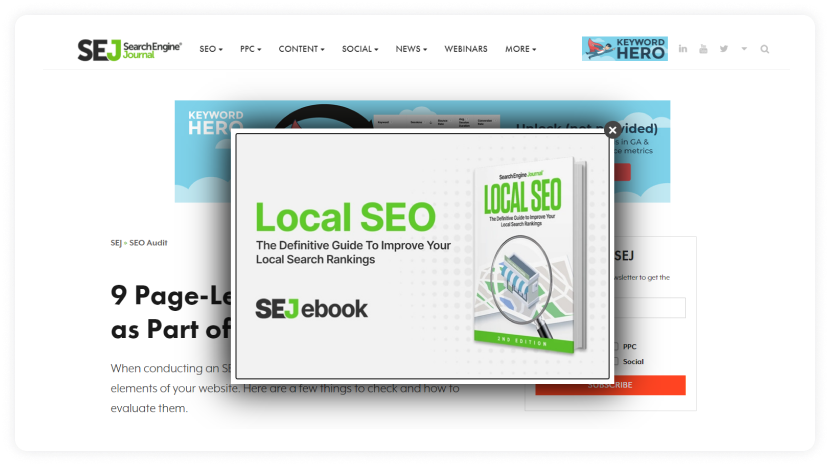
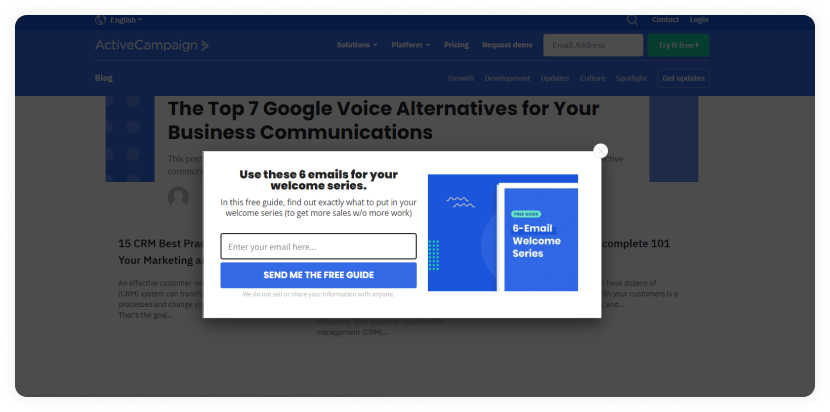
- Giveaway pop-ups
Capture users' attention by offering them exclusive deals if they sign up for your email list.
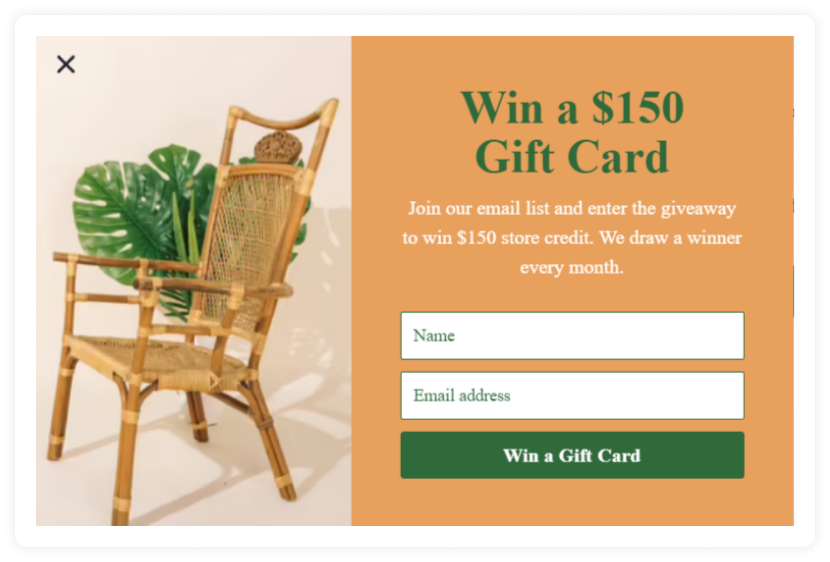
Source: Sleeknote
- Newsletter pop-up
These pop-ups directly ask users to sign up for your brand's newsletter. To encourage more signup, you should highlight what's in it for the user if they subscribe.
For example, Nike gives its users a sneak peek into what they can expect if they sign up for their newsletter - exclusive offers, inspiring content, and news.
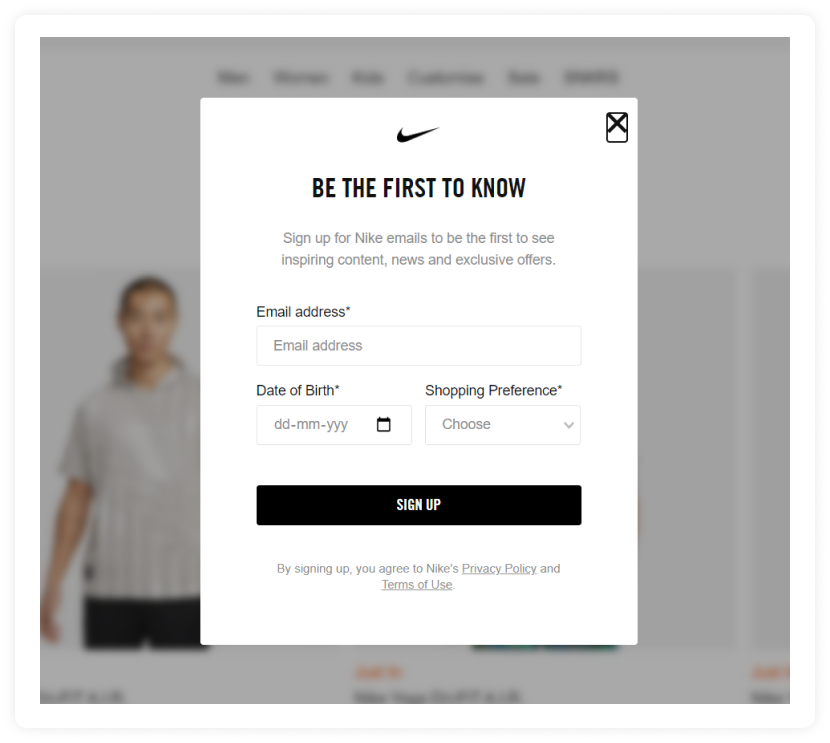
- Content-related pop-ups
These are relevant to the content the user is currently seeing or reading.
For example, HubSpot shows a template pdf pop-up in the right corner of the user's screen relevant to the blog posts the reader is reading - How to Write a Blog Post: A Step-by-Step Guide. The positioning of pop-up doesn't interrupt users' experience and at the same time encourages users to download template files due to higher relevance and usefulness.
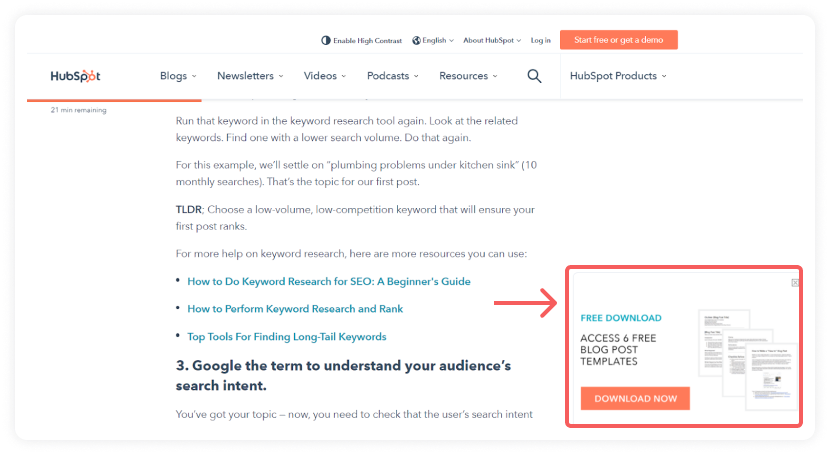
3. Offer premium content, and make them downloadable via contact forms
You can create premium content, also known as gated content, and make them downloadable via contact forms. It can be webinars, ebooks, checklists, white papers, case studies, templates, anything. If your content offers valuable insights to your target audience, then they'll happily share their details with you.
But, the fact that someone has downloaded your content doesn't mean you can add them to your email list. As per General Data Protection Regulation (GDPR,) users must express consent to register by ticking an opt-in box in your download form. So, make sure you add a little checkbox in your signup form to comply with this guideline.
In the example below, Litmus offers downloadable content via contact form. They also mention their privacy policy and how Litmus will use readers' data, thus, complying with GDPR guidelines.
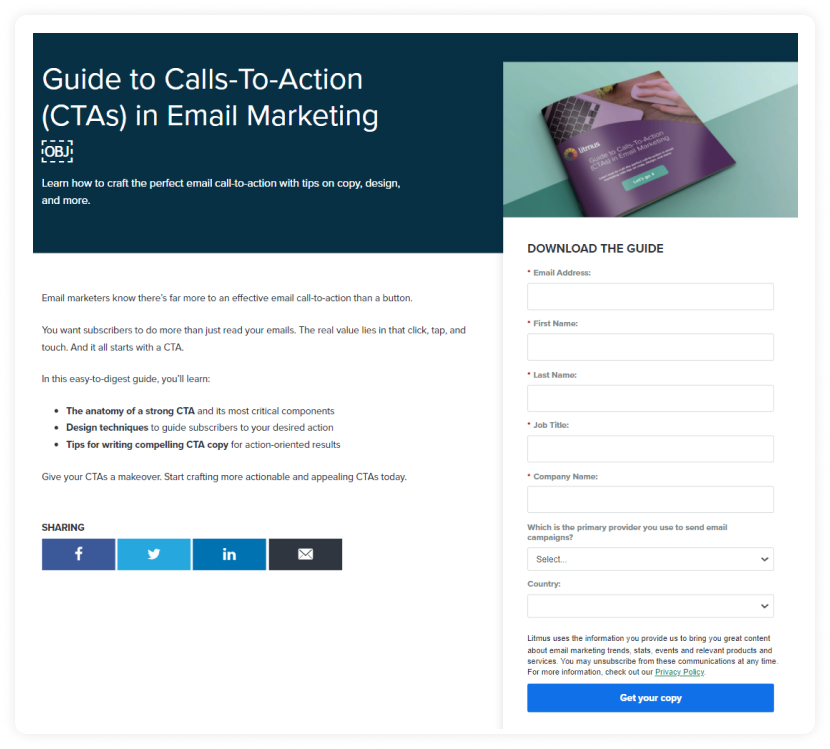
4. Use referral campaigns
You can run referral campaigns and give current subscribers exciting offers, deals, benefits when someone from their reference joins your email list.
For example, Webflow sends this referral email with a unique link for each subscriber to share. And whenever someone joins through this link, the respective user gets beta access to web flow.
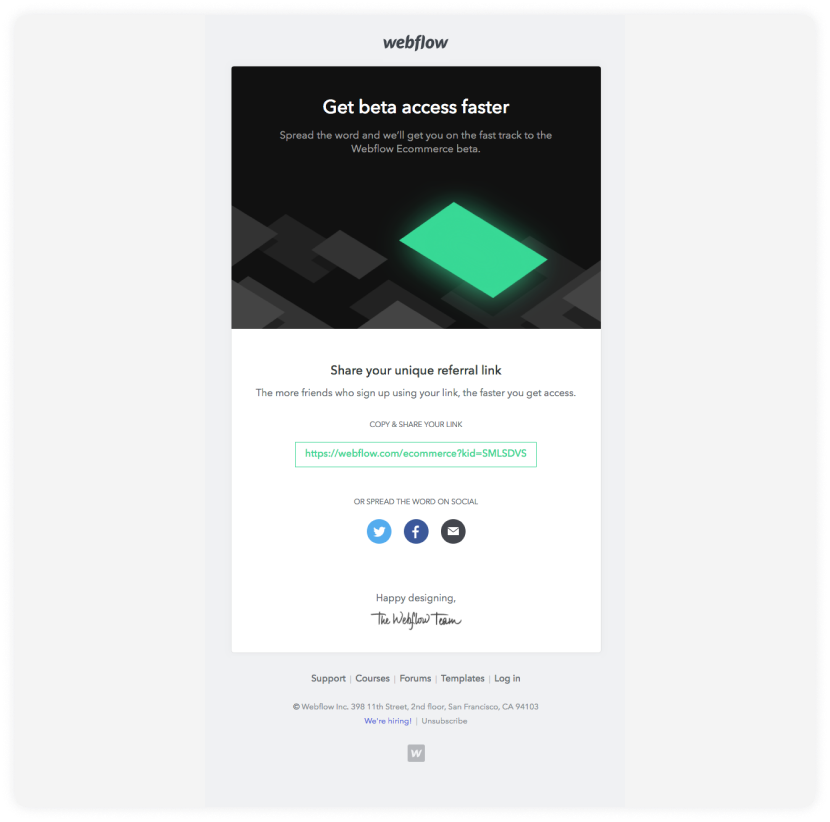
Source: Really Good Email
Besides sending referral emails, you can include a referral section in your newsletter. A great example of this would be Marketing Brew's newsletter.
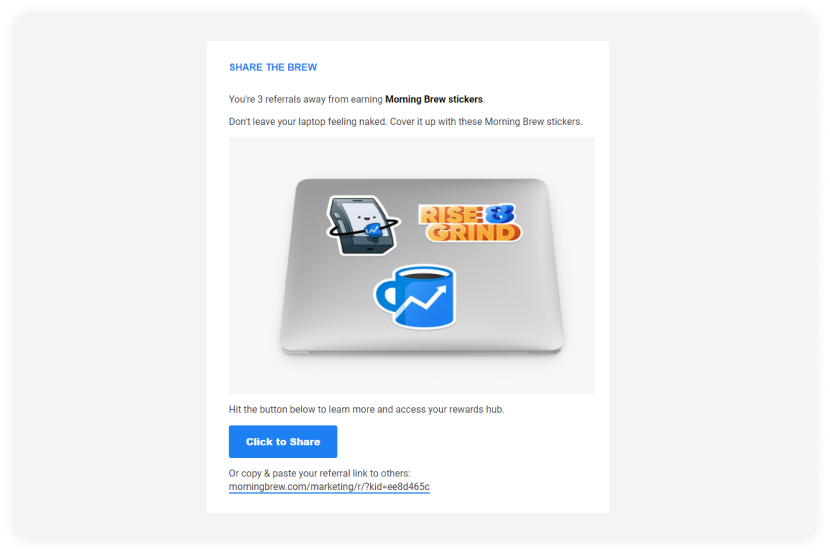
5. Conduct live webinars or guest training sessions
You can conduct live webinars and podcasts on topics relevant to your target audience and promote them to get more registrations.
Besides, you can do guest training and become a guest on someone's podcast. This will help you gain access to that person's audience and leverage it to attract them to sign up for your emails. If you are doing guest training, you can do it for free or charge a fee to do that.
For guest content, you can reach out to agencies, communities, workshops, or brands in your industry and pitch your offer.
It's a great tactic to help other brand audiences know what value you offer without paying any money. And since the owner of that business invited you, it also makes you a credible source in that niche. Hence, leveraging other brands' audiences can help you reach a similar audience as yours and drive traffic to your website.
6. Engage in communities
Communities are an effective way to engage, share and promote your brand. You can meet industry experts, talk to them, get insights, promote your products, etc. Besides, you can promote your upcoming events on different community channels.
There are many communities you can become a part of such as
Demand curve
Superpath
Email geeks
Women of email
Litmus community
Email experience council
The e-marketing association
You can add a link to join your email list in your profile. And if people who connect with you find your content trustworthy and valuable, they might sign up. To check out guidelines for email-related communities, swing by our email marketing resource page.
7. Ask existing customers for feedback via a survey
Your existing customer can be a valuable source of information about your product, brand, and emails. You can send them feedback forms and ask questions such as:
Where did you hear about us?
What do you like most about our product?
What was the reason that made you sign up for our newsletter?
How did you find the signup process?
Any feedback or thoughts you want to share regarding our brand?
You can then analyze the most effective signup channel and work on it with all the responses. If your signup process takes too long, you can shorten it to encourage successful signups.
Moreover, we recommend sending AMP emails to get a higher survey response. Users can complete the form submission within their email with AMP forms, reducing the redirect. Hence, you get a higher submission rate.
An AMP email will work like this in the user's inbox:
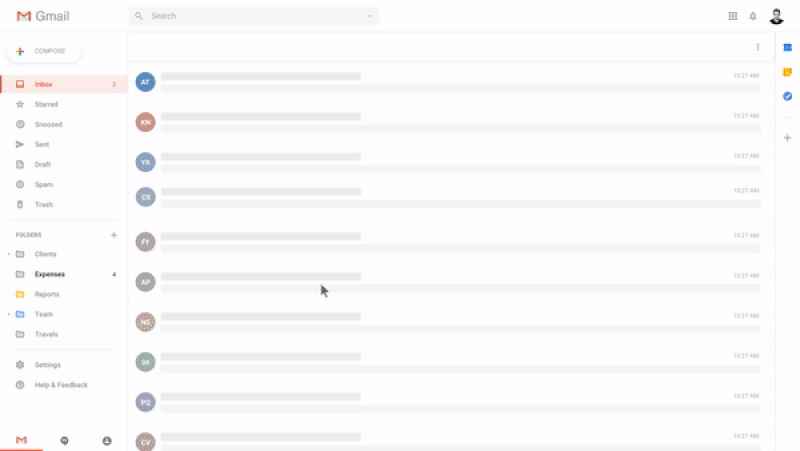
8. Use social media ads to your advantage
Social media ads can effectively promote your newsletter on different social platforms such as Facebook, Twitter, Instagram, etc. You can create specific ads and pages highlighting the benefits of signing up for your newsletter. You can also redirect users to your specific landing pages to encourage signups.
Analyze your target audience and create highly segmented and personalized social ads to get more signups.
Here is an example by The Skimm:
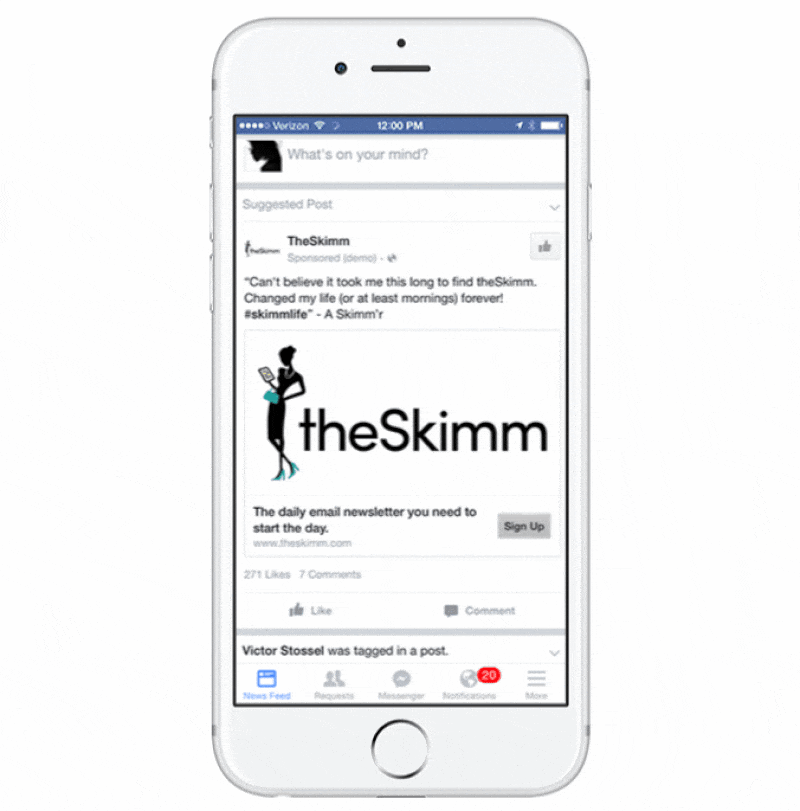
Here are some tips for running ads that get you more signups:
Define your target persona and channel to run ads.
Set up your budget and the time frame you want ads to run.
Pick your ad format - images, videos, slideshows, etc.
Measure the performance by checking analytics tools.
9. Conduct social media contests
Social media is used widely by people, and thus, you can use it to acquire subscribers. One thing you can do is run contests on social platforms and encourage people to join your email list through these contests.
These contests create excitement and give your audience a chance to get involved and unlock different rewards and other benefits. To get the best result, you must have a goal for running these contests.
For example, Foundr, a thought leader digital marketing magazine, launched a 10K giveaway to promote their newly launched training module.
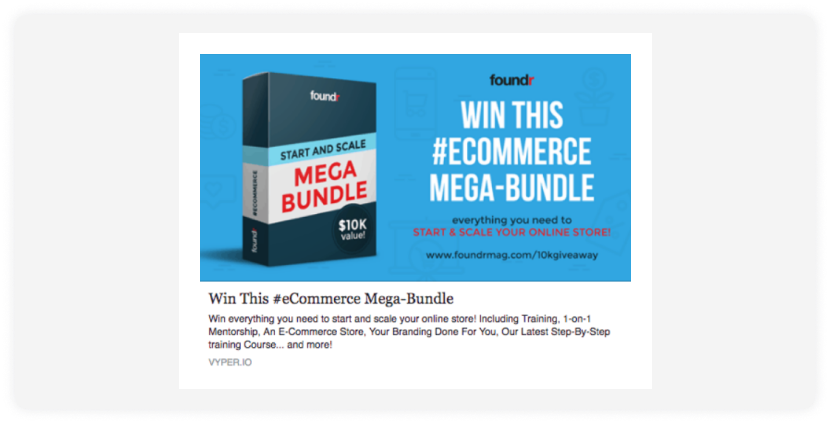
Their goal was to get at least 5000 new subscribers but instead, their contest was so popular that they got 13K+new email subscribers, 1000 subscribers on Youtube and got 19K views on their Facebook page.
You can run different types of contests - video contest, photo contest, hashtag contest, giveaway contest, selfie contest, etc. But keep in mind that your contest should be linked to your newsletter content so that subscribers get only relevant communications if they sign up.
Here are some tips for launching your social media contest:
Identify your goals for running contests.
Determine which social media channel you will use based on your goals, target audience, industry, etc. For example, if you are a B2C brand, you may use Instagram and Facebook.
Then, decide the type of contests you want to run and define rules and guidelines.
Make sure to give a compelling giveaway to encourage people to participate and share your contest.
10. Use Facebook groups
To use this tactic, you need to have an active Facebook group. You can set up rules and guidelines for joining your group and create a form to fill out before becoming a member. You can use this form to collect email addresses or get to know prospective customers. How? One way is to ask users to share their email addresses in exchange for exciting offers, deals, free resources, goodies, etc.
The Email marketing Show has their Facebook group where they prompt users to fill out a form that asks for their email address.

11. Get endorsement from other brands and people
Reach out to brands with a similar target audience as yours and ask them to mention you in their emails.
For example, you may have resources (free or paid) and ask other brands to mention that to their email subscribers. Of course, they will charge a fee depending upon how many subscribers or clicks they send your way. To track it efficiently, you can generate an affiliate link and offer them a commission when someone from their endorsement becomes your customer.
You can see an endorsement in action in the following example. This email by Really Good Emails (RGE) endorses Dyspatch's webinar. This will help Dyspatch reach RGE's audience and get more registrations for their event.
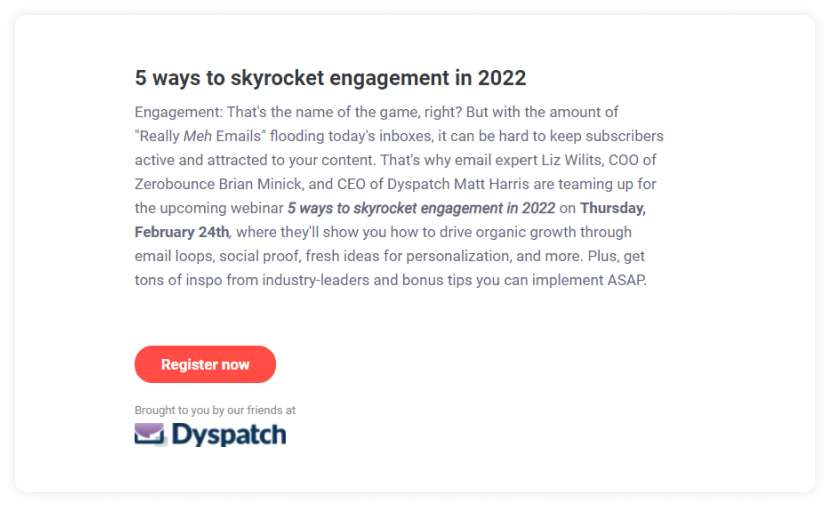
Related guide: 5 Hacks to Boost Your Returning Customer Rate Using Email Marketing
Way forward
Acquiring customers is crucial to gaining traffic to your site and increasing sales. But, once you have acquired customers, don't forget to nurture them and keep them engaged with your emails. Your next step should be to develop an email marketing strategy to help you retain your customers. Develop a loyal customer base today and reap rewards tomorrow!
What you should do next
Hey there, thanks for reading till the end. Here are 3 ways we can help you grow your business:
Talk to an email expert. Need someone to take your email marketing to the next level? Mailmodo’s experts are here for you. Schedule a 30-minute email consultation. Don’t worry, it’s on the house. Book a meet here.
Send emails that bring higher conversions. Mailmodo is an ESP that helps you to create and send app-like interactive emails with forms, carts, calendars, games, and other widgets for higher conversions. Sign up now and send 10k free emails/month. Sign up here.
Get smarter with our email resources. Explore all our knowledge base here and learn about email marketing, marketing strategies, best practices, growth hacks, case studies, templates, and more. Access guides here.

